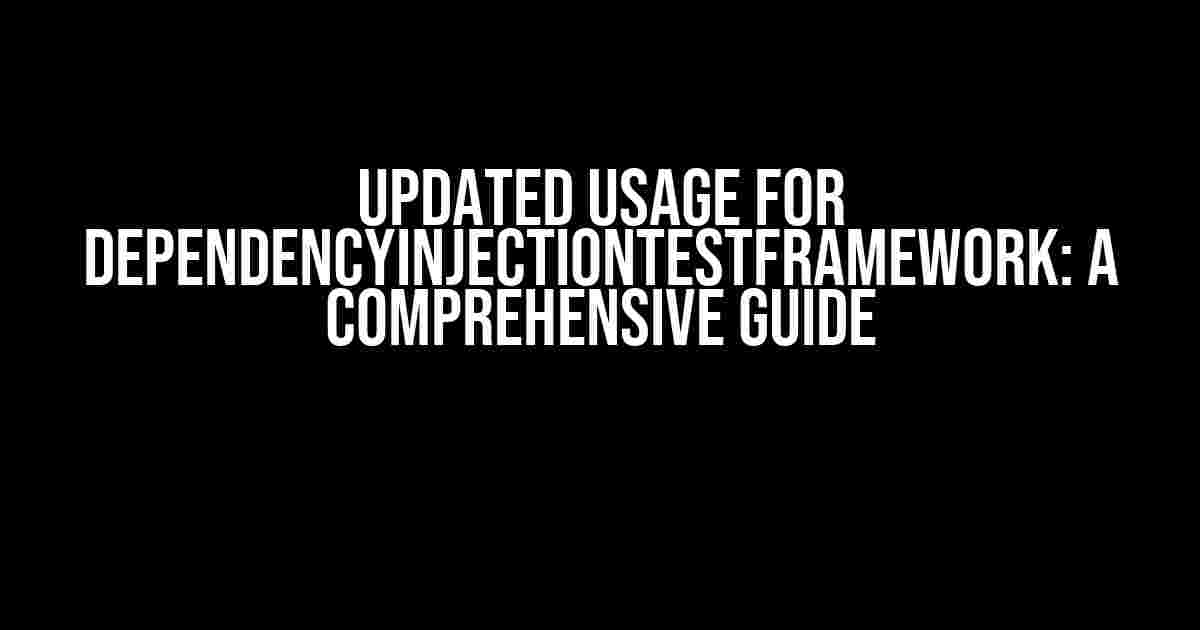Are you tired of writing cumbersome and brittle unit tests for your .NET applications? Look no further! The DependencyInjectionTestFramework has got you covered. In this article, we’ll dive into the updated usage of this powerful testing framework, exploring its features, benefits, and best practices. By the end of this guide, you’ll be equipped with the knowledge to write efficient, modular, and maintainable tests for your .NET applications.
What is DependencyInjectionTestFramework?
The DependencyInjectionTestFramework is a testing framework designed to simplify the process of writing unit tests for .NET applications that rely on dependency injection. It provides a set of tools and APIs that enable you to easily mock dependencies, configure test environments, and write flexible and reusable tests.
Key Features and Benefits
- Modular Testing: Break down your application into smaller, independent components and test them in isolation.
- Easy Dependency Mocking: Mock dependencies with ease, reducing test complexity and increasing test speed.
- Test Environment Configuration: Configure your test environment to mimic production-like conditions.
- Reusability: Write tests once and reuse them across different testing scenarios.
Getting Started with DependencyInjectionTestFramework
Before we dive into the updated usage, make sure you have the following prerequisites:
- .NET Core 3.1 or later
- Visual Studio 2019 or later (optional)
- DependencyInjectionTestFramework NuGet package installed
Installing the DependencyInjectionTestFramework NuGet Package
Install-Package DependencyInjectionTestFrameworkBasic Test Structure
A typical test using the DependencyInjectionTestFramework follows this structure:
using DependencyInjectionTestFramework;
using Microsoft.Extensions.DependencyInjection;
public class MyTest : IClassFixture<MyTestFixture>
{
private readonly MyTestFixture _fixture;
public MyTest(MyTestFixture fixture)
{
_fixture = fixture;
}
[Fact]
public void MyTest()
{
// Arrange
var myService = _fixture.GetService<IMyService>();
// Act
var result = myService.DoSomething();
// Assert
Assert.True(result);
}
}Updated Usage for DependencyInjectionTestFramework
In this section, we’ll explore the updated usage of the DependencyInjectionTestFramework, including new features, enhancements, and best practices.
Mocking Dependencies with Moq
The DependencyInjectionTestFramework now supports Moq, a popular mocking library for .NET. To use Moq, simply install the Moq NuGet package and configure your test environment:
using Moq;
using DependencyInjectionTestFramework;
public class MyTestFixture : IDisposable
{
public IServiceProvider ServiceProvider { get; private set; }
public MyTestFixture()
{
var services = new ServiceCollection();
services.AddTransient<IMyService, MyService>();
// Configure Moq
var moqSettings = new MoqSettings();
moqSettings.DefaultValue = DefaultValue.Mock;
services.AddSingleton<MoqSettings>(moqSettings);
ServiceProvider = services.BuildServiceProvider();
}
public void Dispose()
{
ServiceProvider.Dispose();
}
}Test Environment Configuration
The DependencyInjectionTestFramework provides a range of test environment configuration options, including:
- IServiceProvider: Configure the service provider to return specific instances or mock implementations.
- TestStartup: Customize the test startup process by overriding the CreateWebHostBuilder method.
- TestEnvironment: Define environment-specific settings, such as database connections or API endpoints.
public class MyTestFixture : IDisposable
{
public IServiceProvider ServiceProvider { get; private set; }
public MyTestFixture()
{
var services = new ServiceCollection();
services.AddTransient<IMyService, MyService>();
// Configure test environment
services.AddSingleton<TestEnvironment>(new TestEnvironment
{
EnvironmentName = "Test",
DatabaseConnectionString = "Server=tcp:localhost,1433;Database=mydatabase;User ID=myuser;Password=mypassword;",
});
ServiceProvider = services.BuildServiceProvider();
}
public void Dispose()
{
ServiceProvider.Dispose();
}
}Reusing Tests with Shared Fixtures
Share fixtures across multiple tests to reduce test duplication and improve maintainability:
public class MySharedFixture : IDisposable
{
public IServiceProvider ServiceProvider { get; private set; }
public MySharedFixture()
{
var services = new ServiceCollection();
services.AddTransient<IMyService, MyService>();
ServiceProvider = services.BuildServiceProvider();
}
public void Dispose()
{
ServiceProvider.Dispose();
}
}
public class MyTest1 : IClassFixture<MySharedFixture>
{
// ...
[Fact]
public void MyTest1()
{
// Arrange
var myService = _fixture.GetService<IMyService>();
// Act
var result = myService.DoSomething();
// Assert
Assert.True(result);
}
}
public class MyTest2 : IClassFixture<MySharedFixture>
{
// ...
[Fact]
public void MyTest2()
{
// Arrange
var myService = _fixture.GetService<IMyService>();
// Act
var result = myService.DoSomethingElse();
// Assert
Assert.True(result);
}
}Best Practices for Using DependencyInjectionTestFramework
To get the most out of the DependencyInjectionTestFramework, follow these best practices:
| Best Practice | Description |
|---|---|
| Keep tests simple and focused | Avoid complex test scenarios and focus on testing individual components in isolation. |
| Use dependency injection consistently | Inject dependencies consistently throughout your application to simplify testing and improve maintainability. |
| Mock dependencies judiciously | Mock dependencies only when necessary, and use realistic mock implementations to ensure accurate test results. |
| Use shared fixtures wisely | Share fixtures across multiple tests to reduce duplication, but avoid over-sharing, which can lead to test complexity and maintenance issues. |
Conclusion
The DependencyInjectionTestFramework is a powerful tool for simplifying and streamlining unit testing for .NET applications. By following the updated usage guidelines and best practices outlined in this article, you’ll be able to write efficient, modular, and maintainable tests that ensure the reliability and quality of your .NET applications.
Happy testing!
Frequently Asked Questions
Get ahead with the updated usage of DependencyInjectionTestFramework and clear your doubts with our expert answers!
What is the primary purpose of DependencyInjectionTestFramework?
The primary purpose of DependencyInjectionTestFramework is to simplify unit testing by allowing you to easily mock dependencies and isolate the system under test, making it easier to write and maintain robust unit tests.
How do I configure DependencyInjectionTestFramework in my project?
To configure DependencyInjectionTestFramework, you need to create a test module that inherits from the framework’s test module class, and then register your dependencies using the framework’s registration APIs. You can find detailed instructions in the official documentation.
What types of dependencies can I mock with DependencyInjectionTestFramework?
You can mock any type of dependency using DependencyInjectionTestFramework, including interfaces, classes, and even concrete instances. The framework provides a range of features to help you create realistic mock objects that mimic the behavior of your real dependencies.
Can I use DependencyInjectionTestFramework with existing testing frameworks?
Yes, DependencyInjectionTestFramework is designed to be testing-framework-agnostic, meaning you can use it with popular testing frameworks like NUnit, xUnit, or MSTest. Simply integrate the framework into your test project and start writing unit tests with ease.
What kind of support does DependencyInjectionTestFramework offer?
DependencyInjectionTestFramework provides extensive support through its official documentation, community forums, and GitHub repository. You can also reach out to the framework’s maintainers and contributors for personalized assistance and feedback.






